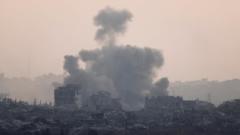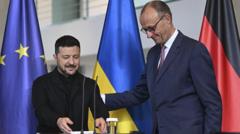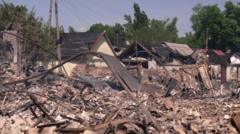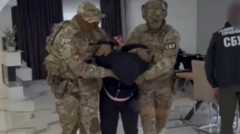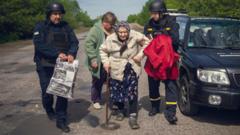The town of Rodynske, near the embattled city of Pokrovsk, showcases the changing tactics employed by Russian forces, with the use of fibre optic drones becoming a significant threat. As Ukrainian soldiers adapt to new warfare technologies, the humanitarian toll continues to rise, highlighting the emotional strain on both military personnel and families affected by the conflict.
The Evolving Battlefield: How Fibre Optic Drones Are Reshaping the Conflict in Ukraine

The Evolving Battlefield: How Fibre Optic Drones Are Reshaping the Conflict in Ukraine
Recent developments in the Ukraine conflict reveal the chilling impact of new technology, notably fibre optic drones, on the frontline dynamics and civilian life.
The acerbic scent of destruction lingers in the air as we arrive in Rodynske, a town that has just experienced a devastating assault. A 250kg glide bomb has not only struck its administrative building but has also obliterated three residential blocks, leaving behind a chilling reminder of the war's harsh reality. Despite being a day after the bombing, smoke still wafts from the remnants of the structure, while the distant thundering of artillery and gunfire indicates a continuous battle against invading drones.
Situated 15km (9 miles) north of the beleaguered city of Pokrovsk, Rodynske has become a focal point of Russian military strategy since their drive for encirclement intensified over the past fortnight. This shift in tactics comes as diplomatic negotiations for a ceasefire remain stagnant, pushing Russian forces to make their most considerable traction since January.
Our visit compounds the evidence of escalating hostilities as a Russian drone looms ominously overhead. With adrenaline coursing through us, our team instinctively seeks refuge behind the nearest cover—a tree. Moments later, the sound of an explosion affirms our fears: another drone has struck nearby. It’s a grim reminder that the frontlines of this conflict are ever-changing and increasingly perilous.
The threat posed by Russian drones, particularly fibre optic-enabled ones, has become an alarming reality for Ukrainian forces. These drones, connected to the operator via a cable that transmits data away from conventional radio frequencies, are proving to be exceptionally deadly. One Ukrainian soldier, known as Moderator, explains that the deployment of such drones gives Russia a tactical edge due to their unique abilities that avoid jamming technology.
As we interview soldiers from the 5th Assault Brigade, it becomes clear that the intensity of drone assaults is on the rise. They recount how their operations are severely hampered by the increasing need to remain vigilant against drone surveillance as they await optimal conditions to engage effectively. Some troops share anecdotes of prolonged deployments, revealing the toll this warfare technology takes not just on military strategy, but also on morale.
Just beyond the frontline, a civilian's perspective adds a heart-wrenching layer to the conflict. Svitlana, a local resident, reflects on the transformation of her home district into a war-torn shell, recounting past instances when explosions felt distant, unlike the jarring reality she now lives. For families like hers, the escalating violence inches closer, forcing them to grapple with loss and uncertainty.
Meanwhile, the soldiers share stories of their own sacrifices, with many enlisting after the onset of war, navigating their new roles amid relentless combat. Conversations with the men reveal personal struggles, such as Maksym’s emotional battle as he tries to remain connected with his two-year-old son through video calls while stationed near the danger zone.
As the conflict stretches into a new summer, the fundamental challenges facing Ukraine—both in terms of manpower and military resources—remain stark. The use and threat of fibre optic drones has transformed the nature of combat, turning previously routine tasks such as moving troops into highly dangerous endeavors. The fragmented war landscape now resembles more a game of chess than traditional combat lines, complicating any visual assessments of territorial gains.
Despite recent advancements made by Russian troops, experts caution that fully seizing the Donetsk region will still pose significant challenges. As Ukraine endeavors to bolster its defenses, the intrepid spirit of its soldiers continues to be tested alongside their unwavering commitment to protect their homeland and loved ones.






